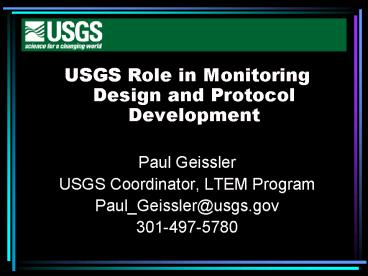USGS Role in Monitoring Design and Protocol Development - PowerPoint PPT Presentation
1 / 16
Title:
USGS Role in Monitoring Design and Protocol Development
Description:
Natural Resources Preservation Program (NRPP) $2.8M (Regions) ... Mammoth Cave (FY2006) Colorado Plateau Cluster (FY2007) Tasks Supported By USGS LTEM ... – PowerPoint PPT presentation
Number of Views:18
Avg rating:3.0/5.0
Title: USGS Role in Monitoring Design and Protocol Development
1
- USGS Role in Monitoring Design and Protocol
Development - Paul Geissler
- USGS Coordinator, LTEM Program
- Paul_Geissler_at_usgs.gov
- 301-497-5780
2
- USGS Direct Support for NPS
- Natural Resources Preservation Program (NRPP)
2.8M (Regions) - Long-Term Ecological Monitoring (LTEM) 1.2M
(Paul Geissler) - Vegetation Mapping Program 1.2M (John Mosesso)
- Park Oriented Biological Support USGS/NPS 0.6M
(Hardy Pearce)
3
- USGS Support for NPS
- Support From Science Centers and Individual
Scientists - Other projects assist parks, although they are
not park specific - Amphibian Research Monitoring Initiative
- Breeding Bird Survey
- Gap Analysis Program
- Integrated Taxonomy Information System
- National Biological Information Infrastructure
4
- Natural Resources Preservation Program (NRPP)
- Short-term, tactical research to meet natural
resource management needs of the National Park
Service. - Fill gaps in applied biological research in the
Nations national parks and allow USGS to address
research needs significant to park resource
managers. - Proposals from NPS
5
- Park Oriented Biological Support
- Joint USGS / NPS funding.
- Focuses on technical assistance and
exploratory research projects. - Provides seed money for new research on emerging
issues that may become significant to the parks,
and to develop products useful to the parks.
6
- Park Oriented Biological Support
- Proposals by USGS scientists working with Park
resource managers - Selection by a panel of BRD and NPS reviewers.
7
- Long-Term Ecological Monitoring (LTEM)
- 11 Parks were selected competitively by NPS as
prototypes, each representing a biome. - Conceptual model is developed which identifies
and relates - Natural resources and ecological processes
- Threats
- Park mission and priorities
- Who is interested in the data why?
8
- Prototype Long-Term Ecological Monitoring (LTEM)
- Indicators (vital signs) are selected
- USGS develops, tests and peer reviews protocols
and procedures in cooperation with park resource
managers. - USGS scientists are stationed at parks to help
develop an operational monitoring program.
9
- Prototype Long-Term Ecological Monitoring (LTEM)
- Once monitoring becomes operational after about
5 years, NPS takes over the monitoring funding. - Handoff review to assure that monitoring is
effective and meets park needs. - USGS funds roll over to the next park.
- USGS continues to support the protocols and
their revision, as necessary.
10
- LTEM Operational Parks
- Channel Islands
- Great Smokey Mountains
- Shenandoah
- Great Plains Prairie Cluster
11
- LTEM Parks Developing Protocols
- (projected completion)
- Virgin Islands Cluster Parks (FY2002)
- Cape Cod (FY2002)
- Denali (FY2004)
- Olympic (FY2006)
- North Cascades (FY2006)
- Mammoth Cave (FY2006)
- Colorado Plateau Cluster (FY2007)
12
- Tasks Supported By USGS LTEM
- FY2002
- Selected in consultation with NPS LTEM
- Workshop to suggest statistical methods of
measuring change (trends) in populations. - Statistical support for park monitoring
- Wes Newton, Northern Prairie
- Post Doc, Patuxent
13
- Tasks Supported By USGS LTEM
- Web site and discussion about development and
use of monitoring protocols. - Complements excellent site Steve has developed.
- Will provide continuing support.
- Could be used to post statistical questions.
- Being developed suggestions will be welcome.
14
- Tasks Supported By USGS LTEM
- Development of improved methods for estimating
detectability - Proportion of area occupied
- Physical simulations
- Chronic Wasting Disease
15
- Tasks Supported By USGS LTEM
- Protocol development and review
- Mountain Lion
- Native Bees
- Vegetation
- Intertidal, Seabirds, and Landbirds
- Calling Amphibians
- Cryptogams
16
- The need for technical support will almost always
exceed the resources available. - If you have funding for work in addition to the
above, - the USGS would like to compete for your project.
- We have expertise in biology, water, geology and
mapping.































